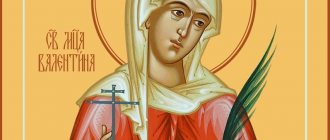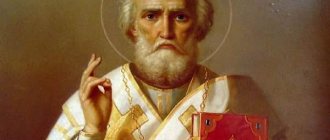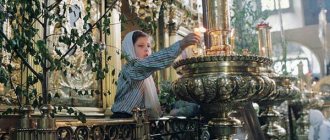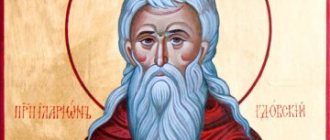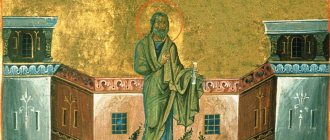Each person who has been baptized has his own heavenly patron saint, and the day of remembrance of this saint is called name day. Mark's name day occurs in the Saints 20 times a year. Usually, a name day is considered to be the day of remembrance of a saint, coming after a person’s birthday. It also happens that a person himself chooses the saint closest to himself, then the name day falls on his day of memory.
Apostle and Evangelist Mark Memorial Day: May 8
Saint Mark is the author of one of the four Gospels. He wrote it shortly before the destruction of Jerusalem by the Romans in 70. Most of all about Saint Mark is said in the Acts of the Apostles. From this book we know that Mark's original name was John and that he was the nephew of the Apostle Barnabas, a companion of the Apostle Paul.
We first meet Mark in Jerusalem. Here his mother Mary had a house, which often served as a meeting place for the apostles after Christ ascended to Heaven. There is, however, an assumption that in the same house there was an upper room in which the Lord celebrated the Last Supper on the eve of His suffering.
"St. Mark the Evangelist", wooden relief miniature. Germany, 1200-1225
In the Gospel of Mark we find a seemingly insignificant episode. The last meal of Jesus with his disciples is over, soldiers have already entered the Garden of Gethsemane - and suddenly a certain young man, wrapped in a veil over his naked body, rushes after Jesus, who is being taken away to trial. The soldiers grab him, but he dodges and, leaving the blanket, runs. Why does the evangelist talk about this? Perhaps he was that same young man, and this story was dear to him as a memory of his personal involvement in the events of Gethsemane. From a human perspective, this is quite understandable: Mark did not participate in the Last Supper (he was not part of the circle of 12 closest disciples of Christ - perhaps he was still too young), he was probably already sleeping, when he suddenly heard a noise, ran out of the house, throwing a blanket over himself. whatever happened - and caught the denouement of events. Unable to figure out what was going on in his sleep, he hurried after the Teacher, was detained by soldiers, got scared and slipped away...
At first, Mark was especially close to the Apostle Peter, the informal leader of the apostolic community. From him he received instruction in faith - it is not for nothing that Peter calls Mark his son, obviously meaning spiritual kinship. And Mark will write down his Gospel, according to legend, precisely from the words of Peter.
As an adult, Mark accompanied his uncle Barnabas and the apostle Paul on their missionary journey to Cyprus, where Barnabas (and possibly Mark) was from. Paul and Barnabas then went on to preach further, and Mark returned to Jerusalem. Pavel did not like this, and for a while he stopped taking Mark with him. Although he later spoke of Mark as one of his most reliable companions.
Cathedral of San Marco, Venice
Mark also had a chance to travel with the Apostle Peter. He accompanied the chief apostle to Rome, the then capital of the world, and after gaining experience, he went to preach in Aquileia, a rich city on the shores of the Adriatic Sea not far from present-day Venice.
Then, at the direction of Peter, Mark went to Egypt, where he became the founder of the entire Local Church. Many Jews lived in Alexandria in Egypt for a long time. Moreover, back in the 3rd-2nd centuries BC, Jewish scribes living in Alexandria translated the Old Testament into Greek. All this became a good basis for preaching the Gospel, with which the Apostle Mark introduced both Egypt and neighboring countries like Libya.
Saint Mark was killed on Easter, which coincided that year with the holiday in honor of the pagan god Serapis. The pagans grabbed the apostle and dragged him on a rope through the streets and outskirts of Alexandria. Mark soon died from his wounds. Tradition says that the pagans wanted to burn his body, but they were stopped by a terrible thunder and earthquake. Christians buried the body of the apostle, and in the 9th century, when Egypt fell under Muslim rule, they transported his relics to Venice.
In mythological representations[edit | edit code]
Elixir of Youthedit | edit code
White Moon Hare preparing the elixir of youth under the cassia tree.
Embroidered medallion on the imperial robe. China, 18th century Elixir of youth (immortality) is a substance that has the property of rejuvenating the human body and prolonging its life indefinitely. The elixir of youth is mentioned in the legends and traditions of many peoples as a kind of “food” of the gods. The gods of Ancient Greece ate ambrosia, the gods of Ancient India - amrita, the Iranian gods - haoma, the gods of Ancient Egypt drank the water of immortality.
Alchemists devoted a lot of time and effort to the search for the elixir of youth (see elixir of youth). In their opinion, gold, which is an extremely durable (“noble”) metal, must contain a substance that makes it eternal. Alchemists set out to isolate this substance or find a way to introduce it into the human body along with gold.
In particular, Cleopatra drank a drink made using this “technology” [ source not specified 3685 days
]. Since she soon committed suicide, it is impossible to judge the success of the experiment.
The personal physician of Pope Boniface VIII suggested mixing crushed gold, pearls, sapphires, emeralds, rubies, topazes, white and red corals, ivory, sandalwood, deer heart, aloe root, musk and ambergris; it was believed that this composition could become an elixir of immortality.
There is a well-known case with the Chinese Emperor Xuanzong (8th century). The court alchemist prepared a preparation for him. During the preparation process, the drug was boiled for a year. However, a month after taking the “elixir of youth,” the emperor died.
Legends of immortalityedit | edit code
It is alleged that the Indian Tapasviji lived 186 years (1770-1956), which is officially indicated in the documents of his principality. He was a Raja in Patiala, but after reaching the age of 50 he retired to the Himalayas and began to lead the life of a hermit; By practicing yoga, Tapasviji achieved perfection in controlling the processes occurring in the body (the state of samadhi). Tapasvizhdi left evidence of a meeting with an old hermit who did not speak any of the modern languages and knew only Sanskrit, which was spoken by the inhabitants of Ancient India. According to the old man, about 5 thousand years have passed since he became a hermit. He managed to achieve longevity thanks to a special drink, that is, the elixir of immortality. The old man handed over some of the drink to Tapasviji. The drink had to be taken once every 10 years. After Tapasviji's death, a thorough and unsuccessful search was made in his house in order to find a cup containing a liquid that no one had previously been allowed to touch. [ source not specified 3464 days
]
In modern gerontology, messages of this kind are viewed as having nothing to do with reality.
Immortality can be perceived as a curse, as, for example, in the legend of Ahasfera or in Jonathan Swift’s depiction of disgusting immortal old men - Struldbrugs, who remembered only the events of the first 80 years of life.
Other saints and famous people named Mark
Venerable Mark the Ascetic (4th century - early 5th century)
According to legend, this saint knew all the Holy Scriptures by heart and lived for more than a hundred years. He labored in the Egyptian desert. The Church values him as one of the most important ascetic writers of the Orthodox East: in particular, he authored “200 chapters on the spiritual law” and the essay “To those who think to be justified by works.”
Saint Mark of Ephesus (1392–1444)
The main defender of Orthodoxy at the Ferraro-Florence Council of 1438–1439, where the Byzantine Emperor John VIII Palaiologos and Patriarch Joseph of Constantinople, frightened by the victories of Turkish arms, signed a union with the Catholic Church under pressure from Pope Eugene. In disputes with Catholics, Saint Mark selflessly defended the purity of Orthodox dogmas, and when the union was finally concluded, he refused to sign the agreement. Having learned about this, Father Eugene said in disappointment: “Well, we didn’t do anything.”
Mark Twain (1835–1910)
American writer, Mark Twain's real name was Samuel Langhorne Clemens. Author of the famous "The Adventures of Tom Sawyer" and "The Adventures of Huckleberry Finn"; from the latter, according to Ernest Hemingway, all modern American literature emerged. During his lifetime, he achieved success thanks to the book “Simps Abroad,” written while traveling around Europe (including Russia). Later, his name was glorified by the books “The Prince and the Pauper,” “A Connecticut Yankee in King Arthur’s Court,” and the autobiographical collection “Life on the Mississippi.”
Mark Zakharov (born 1933)
Famous Russian film and theater director, artistic director of the Lenkom Theater. Among the most famous works are film adaptations of the novel “The Twelve Chairs” by Ilya Ilf and Evgeny Petrov, plays by Evgeny Schwartz (“An Ordinary Miracle”, “Kill the Dragon”) and Grigory Gorin (“That Same Munchausen”, “The House That Swift Built”, “ Love Formula"). In 1987 he received the USSR State Prize for staging the plays “Juno and Avos” and “Dictatorship of Conscience.”
Order of Knights
In the 4th century BC, the Holy Grail became a symbol of the spirit of adventure, the magic of the surrounding world, the interweaving of myths and the mysticism of the teachings of Christ. Ancient Egypt during this period became the site of the creation of the Order of the Grail Knights. Its occurrence is associated with Lucifer's attack on the castle of Montsegur, which was owned by the first king of the Grail, Titurel. For protection, the knights united in the Order and vowed to always be on guard of the magical object. After some time, this society settled in Palestine. King Solomon, who ruled there, wore the Grail in the form of a stone in a ring. Later, the magical object was reincarnated into a cup, the keepers of which were the knights of King Arthur’s Round Table.
When the world became too sinful, the Order of the Grail Knights decided to move the cup to a holy place. They went to the East, where they ended up in the country of Shambhala. This is a mysterious place with eternal spring and flowing fountains of youth. Here, on Mount Monsalvat, the knights build a castle, which becomes the haven of the Grail. Around the mountain, according to legend, lies the Star Ocean and the River of Time flows. Only a select few, summoned by a magical object, can enter the castle.
"The Gospel of Peter"
Lion of the Apostle Mark in Piazza delle Erbe in Verona, region. Venice, Italy
It is believed that the Apostle Mark wrote his Gospel for the Christians of Rome, based on the testimony of his teacher, the Apostle Peter. Mark made his narrative eventful and paid relatively little attention to the content of the Savior’s sermon. Mark especially highlights those events that testify to the royal power of Christ, therefore the Church chose the lion, the king of beasts, as the symbol of this evangelist.
Church tradition
The centurion Longinus, who pierced the body of the Savior, believed in Christ and went with sermons to pagan countries - to the Caucasus and Transcaucasia. It is believed that he left his Spear in the lands of ancient Armenia. According to another version, the tip of the shrine was brought by the Apostle Thaddeus. More than once the peoples of the Caucasus turned to the relic for help. For example, during the reign of Emperor Alexander I, a religious procession carried through the territory of Georgia saved people from a cholera epidemic.
The spear is kept in the sacristy of the Etchmiadzin Monastery. Is it real? Or is this a copy? Hard to tell. Scientists studied relics located both in Armenia and in Vienna, but did not come to a consensus on authenticity.
Reading experience
Metropolitan Anthony of Sourozh told how the Gospel of Mark helped him become a Christian. He picked up this book as a teenager with a completely opposite purpose - he was going to put an end to faith in God once and for all. He did not expect anything good from any of the Gospels, so he decided to read the shortest one. “I was sitting, reading... and suddenly I felt that on the other side of the table, here, stood Christ. I remember that I then sat back and thought: if Christ is standing here alive, it means that this is the risen Christ. This means that I know reliably and personally, within the limits of my personal, my own experience, that Christ has risen, and that means everything that they say about Him is true.”
The evolution of ideas about immortality[edit | edit code]
Immortality. Engraving from the magazine "Iskra". Bulgaria, 1891
The idea of immortality is found, in one form or another, among all ancient peoples. Among the Greeks and Jews, immortality was understood as a ghostly existence in the kingdom of shadows (“Hades” among the Greeks, “Sheol” among the Jews). In India and Egypt, the doctrine of the transmigration of souls prevailed.
Later in Judaism, the doctrine of immortality was already associated with the doctrine of the resurrection of the dead and retribution after death; in this form it passed into Christianity and Islam.
Some philosophical systems consider the incorporeal, extraphysical existence of the soul (esoteric immortalism). The materialistic approach denies the existence of the soul, therefore, within its framework, the question of the possibility of this kind of immortality is meaningless.
In the form of a systematic doctrine, the concept of immortality was first substantiated and developed by Plato (“Phaedo, or On the Immortality of the Soul”). Kant, considering it impossible to find any theoretical proof of the immortality of the soul, based his belief in it on the postulates of practical reason.
Japanese Buddhist monks
To prevent decomposition, internal organs are usually removed during mummification. Therefore, scientists were completely dismayed when they discovered mummies in the Yamagata province of Japan in the 1960s in a completely unchanged state - their organs began to dry out even before death
.
To rid themselves of the illusion of the physical world, earn more than a million years in heaven, and achieve enlightenment before reincarnation, the most devoted Shingon Buddhists mummified themselves as an act of saving humanity.
The monks ate only fruits and nuts for three years, and then pine needles and bark for another three years. Some even drank poisoned tea to ward off insects from their bodies.
And finally, the monk meditated through a breathing tube while in the grave. From time to time he signaled with a bell that he was alive, and when he stopped, his assistants sealed the grave. After three years they opened it, if his body had not decomposed, he was worshiped as a living Buddha
. Even if his body was subject to decomposition, he was buried with special honors. Out of hundreds of monks, only 24 achieved the status of “living Buddha”.
In 1877, self-mummification was abolished by the Japanese Emperor Meiji.
Cups passed off as the Grail
In the 19th century, about 6-7 cities declared that they kept the Grail:
- In the Valencia Cathedral there is a copy of the cup, which was allegedly recognized as authentic by the Vatican itself.
- In 1933, during the Chicago World's Fair, a vessel from the Antiochian treasury was shown as the Holy Grail, which was later dated to the 6th century.
Chalice in the Cathedral of Valencia
In Turin, many guidebooks claim that the famous relic is located here. Near the Cathedral of Our Lady you can see 2 sculptures - Faith and Religion. The sculpture of Vera holds in her left hand a vessel, which in the imagination of the townspeople is an image of the Holy Grail.
It is worth noting that the guidebooks specify that Vera’s gaze shows the direction in which to look for the cup.
James Vaupel, founder of the Max Planck Institute for Demographic Research (Germany)
James Vaupel played a pivotal role in research on demography, aging and longevity. He was one of the first to doubt that the average life expectancy of 85 years was the limit for his generation.
- “Every day we are harmed for which we cannot fully compensate. The accumulation of this type of damage is the cause of age-related diseases.”
- “Hydras direct their resources primarily to restoration, and not to reproduction, like people. Humans have a different survival strategy at the species level. The trick is to increase your ability to regenerate - instead of wasting energy on gaining weight. In theory this should be possible, although no one has the slightest idea how to achieve this."
- “If we can stop the constant damage to our cells and achieve what is called negligible aging, then perhaps there will be no upper limit to our age. If this happens, the reason for us to die at all will disappear.”
The power of the mind
There is no point in reminding us that modern people are constantly under stress, most often over trifles. A restless mind, which Tibetan monks call poison, destroys the body with the same force as bad habits.
If people pay attention to what they think about during the day, they will be amazed. More than 90% of the most powerful force in the Universe - thoughts - is spent on negativity and focusing on the absence of something (no money, no health, no love, etc.)
d.).
Life wisdom is that a person always gets what he focuses on. Everyone knows about this, but only 5% of people on the planet put it into practice; they own 90% of all money, and there is no secret about it. A person is attracted to eternal youth as an achieved result, but at the same time he is afraid of death and thinks about it.
Elixir of Youth in Chinese History
The search for the elixir of Emperor Qin Shi Huangdi
Qin Shi Huangdi (Chinese tr. 秦始皇帝, 259 BC - 210 BC) - Emperor of China, ruler and founder of the Qin dynasty, who put an end to the two-hundred-year era of the Warring States, sincerely believed in the existence of the elixir of youth. A cult had formed on the east coast at that time, which claimed that a person who consumed this elixir “would find eternal life on three sacred mountains in the middle of the sea.” In search of the elixir, Emperor Qin Shi Huangdi poisoned two expeditions. One of these expeditions included hundreds of men and women who headed towards the sacred island mountains, where, according to legend, immortal people lived. There was no further news about them. In this regard, after some time, a second expedition was sent, which included four magicians, one of whom was Teacher Lu, who, upon returning, informed the Emperor about the unsuccessful search, but provided the Emperor with the “magic” text found during the expedition, in which spoke of the imminent fall of the Qin dynasty from the invasion of the Xiongnu barbarians. But the idea of the elixir of immortality did not leave Qin Shi Huangdi throughout his life, and he died from taking the elixir of immortality - pills containing mercury.
Sui Fu's Quest for the Elixir of Immortality
The Chinese Emperor Qin Shi Huangdi had a court magician and fortuneteller Sui Fu (Chinese trad. 徐福, born in 255 BC). The Emperor was very afraid of death and wanted to find a way to live forever. He instructed his magician to organize the search for the elixir of youth and immortality twice: in 219 and 210 BC.
In 219 BC. Sui Fu organized an expedition to Mount Penglai in the ocean, where, according to legend, the celestials were supposed to live, and he himself was supposed to find a recipe for the elixir of immortality. Sui Fu wandered the seas for several years, but never found Mount Penglai. When the Emperor asked Sui Fu about the results of the expedition in 210 BC. e., he replied that the path was impossible to overcome, since it was guarded by giant fish, and in order to kill the fish, the best archers were needed. The emperor needed an elixir, and he provided archers.
So in 210 BC. e. Sui Fu went on a second expedition. It is generally accepted that the Sui Fu fleet consisted of 60 ships, a crew of 5,000 sailors, and 3,000 boys and girls on board the ships. Archers and artisans with different skills also sailed on the ships. After the second expedition, Sui Fu did not return. The Shi Ji says that the fleet arrived in a flat area where there were many swamps. There Sui Fu declared himself king and did not want to go back.
Later chronicles also do not give a definite answer about the place where Sui Fu could have landed. Some chronicles call the place "Danzhou", but its location is not specified. A thousand years later, the monk Yichu of the Later Zhou era (951-960) writes that Sui Fu landed in Japan, and identifies Mount Penglai with Mount Fuji. In Japan, this legend became widespread.
Those who believe that Sui Fu landed in Japan believe that his arrival gave a powerful impetus to the development of ancient Japanese civilization.
The search for Emperor Wu's elixir
Wu Di (Chinese: 漢武帝 (汉武帝), August 27, 156 BC—March 29, 87 BC) was the seventh emperor of the Western Han Empire in China. During his reign, China greatly expanded its territories. Wu Di was also engaged in a serious search for the elixir of youth and immortality; for him it was an obsession. In an active search for immortality, Emperor Wu contacted magicians and spellcasters. Mages from the kingdom of Qi searched for celestials, organizing sacrifices on sacred mountains and sending sea expeditions in search of the island of Penglai, where the immortals live. Emperor Wu gave high positions to the magicians of that time, but also easily executed them afterwards for charlatanism. There is no information about the Emperor’s successful discovery of the elixir of youth.
Tibetan longevity system
Since energy in vital organs decreases with age, the monks have developed recipes to help avoid this.
Yin energy is associated with cold, which causes diseases such as hypertension, cancer, heart attack, atherosclerosis and many others. To counter this, you should increase the yang energy in the heart, liver, kidneys, lungs and spleen with the pancreas.
The recipes for eternal youth for internal organs are very simple, but if you apply them, the aging of the body can be stopped indefinitely:
- pour 50 g of rice and 25 g of sesame seeds with a glass of water and cook for 15 minutes, consume once a day for a week;
- grind 100 g of St. John's wort, immortelle, birch buds and chamomile, brew 1 tbsp before going to bed. spoon of the mixture in half a liter of water, let it brew, strain through a cloth and drink half with a teaspoon of honey in the evening, and the rest 20 minutes before breakfast;
- Pass 400 g of peeled garlic through a garlic press, pour in the juice of 24 lemons, take 1 teaspoon of the mixture after meals, diluted in a glass of water and pre-mixed in a vessel.
Tibetan monks have many more secret methods of rejuvenation, which they carefully keep from outsiders. These recipes were found in one of the monasteries, scratched on clay tablets in the 6th century BC. e.
